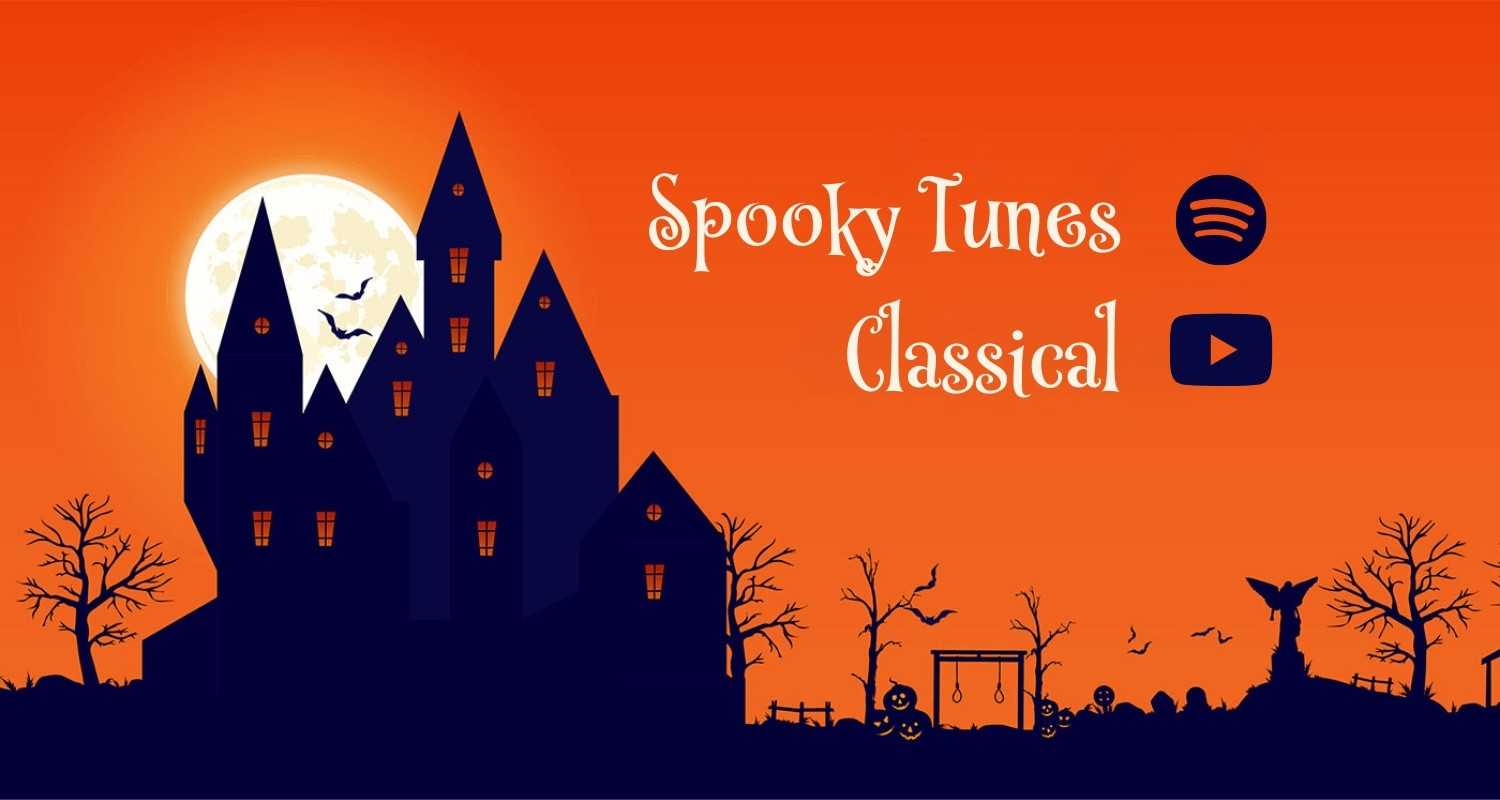by Florian Boberski (25.10.2021)
Translation by Edd Lee (24.10.2022)
Come into the cool catacombs of the most catastrophic classical compositions! Crisp as a cat, you can listen to the clear, concert call in the cold cellar of a cathedral with clattering teeth. Is that an organ I hear? No, for at the beginning of this playlist, one of the most important pieces of all time was arranged for orchestra, in order to be even more effective. Discover the terrific depths of classical music!

The orchestral version of Johann Sebastian Bachs Toccata & Fuge in d-minor, arranged by Leopold Stokowski, may already shock some, particularly those deep double bass tones alone can easily give you goosebumps, but let's dig deeper today.
“La Masque de la Mort Rouge” from Conte Fantastique by André Caplet André Caplet provides perfidious horror... no wonder, since it is the setting of a story by the doyen of scary stories and horror Edgar Allan Poe himself.
Now here we are in the 5th movement of Hector Berlioz's Symphonie Fantastique: The Witches' Sabbath! Shrill sounds of the clarinet, and deep tones of the double basses, glissandi that are guaranteed to give you goosebumps, and chimes that herald the witching hour. Spoiler alert! Have you heard the melody of death? Find out more about it soon…
The beginning of the 3rd movement of Frédéric Chopin's Piano Sonata No. 2 lets us breathe again, but only a little, and rather mechanically, like Darth Vader, who may well have just entered the room! Can you hear the similarity to the Star Wars Imperial March? After all, all good horror stories and films thrive on allowing us only very brief recovery periods. The major section sounds almost sweet, with only a few shocking chords that nearly make us fall out of our rocking chairs. It may only seem slightly scary, but within the context of Chopin's own sad life, it takes on a rather different hue. The genius Chopin, to whom we owe so many beloved piano pieces, died at the age of 39 as a result of tuberculosis, severely depressed and completely penniless... if that doesn’t give you goosebumps, I don’t what will!
It is now in the witching hour. Close your eyes as you listen to Camille Saint-Saëns' Danse Macabre. Whether the composition itself conjures up a scary mood or not, just think of the powerful image of the ghost of Camille Saint-Saëns last December, on the 100th anniversary of his death, at midnight, accompanied by a whole orchestra of all the great deceased composers on a rugged plain or a mountain peak, hidden by a thunderstorm, dancing his Danse Macabre... did you hear the death melody?
Here in Franz Liszts Totentanz right at the beginning, in its purest form, the death melody cannot be ignored. Film music aficionados will immediately think of the hammering and forging orcs from The Lord of the Rings, where Howard Shore quotes this sinister motif.
We use YouTube to embed video content. This Google service has its own cookies and may collect data about your activity. You can find more information in the data protection declaration of the provider. We need your consent to display YouTube videos:
Show YouTube contentNow we come to another very popular horror film device: the church and church music, which also stands for the pure, the divine and the good. The “Dies Irae” from Giuseppe Verdi's Requiem may not be written for a horror film, but it certainly sends shivers down most people’s spines.
Another popular horror film device is the use of children's songs... inherently good and innocent, it is very disturbing when we see children or hear childish music portrayed in a scary way. A music box playing a harmless children's song twisted and distorted makes us shiver. Only one thing is worse: when we find out that Béla Bartók, known for his child-friendly etudes and piano lessons for children, wrote eerie, chilling music himself. In this context, the Music for Strings, Percussion and Celesta by Béla Bartók (3rd movement) is even more sinister! Only a strong Animagus can help us...
Now an excursion into the world of art song. The Erlkönig by Franz Schubert speaks for itself - here in the diabolical version by Ian Bostridge (who, by the way, wrote a great book about Winterreise), accompanied by Julius Drake. Then Der Feuerreiter, the Fire Rider by Hugo Wolf in a version for choir and orchestra. Goosebumps guaranteed!
Choir and horror, the “Ghost Choir“ from Richard Wagner's Fliegenden Holländer cannot go unmentioned, including a wind machine for effect and a great representation of the wind in the orchestra. Inexorably, the undead Dutchmen strike fear into the hearts of the sailors, who try to drive away the howling wind and the eerie songs of the Dutchmen with their ever louder and louder singing... but to no avail!
Last but not least in our Scary Classical Playlist: “Suggestion Diabolique” from Four Pieces op. 4 by Sergei Prokofiev, who is known for giving children sleepless nights with the wolf's theme from his otherwise joyful musical radio play Peter and the Wolf but all's well that ends well.
We use YouTube to embed video content. This Google service has its own cookies and may collect data about your activity. You can find more information in the data protection declaration of the provider. We need your consent to display YouTube videos:
Show YouTube contentAnd of course A Night on the Bare Mountain by Modest Mussorgsky. Another night full of witches, the end of which sounds almost reassuring. Although there was that one melody that could be heard again...
We don't want to keep you in suspense any longer, the experts amongst us already know what we are talking about:
The motif that we have associated with death for at least 800 years is “DIES IRAE”, the day of wrath, the day of judgment. The melody comes from a Gregorian chant and is often attributed to the Franciscan monk Thomas of Celano. However, this is rather doubtful, because there is a codex with the text of the motif that is even older, and dates back to the end of the 12th century...
In the end, a few questions remain unanswered: Has the melody of “Dies Irae” been anchored in our heads since the dawn of time and is it irrefutably synonymous with death? Where is it really from? Is this motif quoted intentionally as a mere homage to the ancient Christian Gregorian chant, or is there more to it than that? By the way, did you know that Halloween is not only an American commercial festival, but was originally widely celebrated in Catholic Ireland and goes back to the much older Celtic Samhain festival?
Now you know, you will probably get a chill everytime you hear the melody of the medieval motif... Joseph Haydn, Hector Berlioz, Johannes Brahms, Franz Liszt, Charles Gounod, Gustav Mahler, Pyotr Ilyich Tchaikovsky, Sergei Rachmaninoff, Mieczysław Weinberg and many more … none of them could resist the spell of this death motif. Especially in films, this motif is often used when death is discussed or portrayed. Whether in Star Wars, The Lord of the Rings, Dracula, Pirates of the Caribbean, Harry Potter, The Lion King, even in Disney's Frozen. You can find more about melody of the Final Judgment and its use in film music here: Why this creepy melody is in so many movies
You could stop now, but you are only one third of the way through your eerie journey! Better start the next playlist now!
